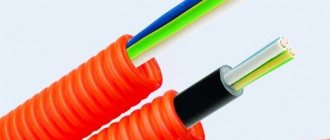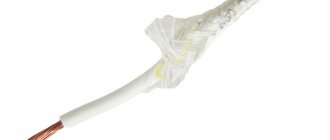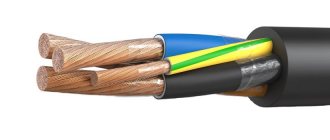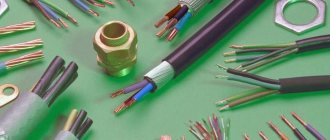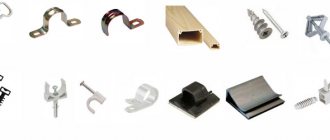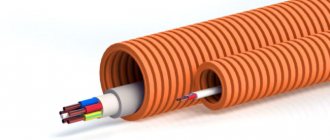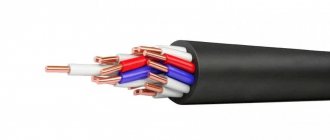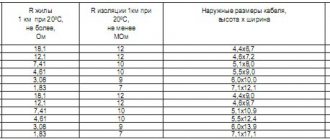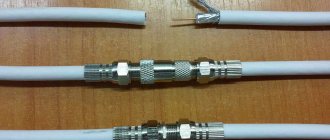The PuGV wire is a power conductor whose cores are made of copper. PVC plastic was used as an insulating composition. This cable is characterized by the absence of a sheath. Produced in accordance with GOST R 53768-2010 standards. The cores are assembled from tinned copper wires (rods). The number of rods is 7 or more. Operation is carried out in enclosed spaces for stationary units. In the absence of direct exposure to solar radiation, installation under canopies is allowed. Work in conditions of precipitation is not allowed. With the closed installation method, installation work can be carried out under layers of plaster, in brick and concrete masonry.
Recommended voltages up to 450 V (in 450/750 V networks). At constant voltage up to 1 kV, including the presence of bending.
Decoding
The PuGV cable is deciphered as follows:
- P is the common name for cable conductors, hereinafter referred to as wire.
- y is an installation-type product used in electrical installation of conductor lines.
- G – wire flexibility index. This marking refers to stranded conductors as opposed to, for example, cords.
- B – PVC is used as insulation.
Thus, this product is a single-core conductor. Current-carrying elements are made of copper wires twisted together. There is no shell, PVC insulation.
The numbers that follow indicate the cross-sectional area of the wire in mm2. For example, PuGV-4. The next letter index characterizes the color marking of the insulation (B - white, K - red, etc.). This condition is discussed when placing an order for the product based on information about the further use of conductor products.
Explanation of the name
Explanation of the abbreviation PuGV:
- P - wire;
- U - installation;
- G - flexible;
- B - with polyvinyl chloride insulation.
PuGV performs a connecting function for electrical installations; it has one core, the cross-sectional area of which is determined depending on the standard size. The core flexibility of conductors of this type can be of three classes: 3, 4 or 5 according to GOST standards. The cable can be used in moderate and cold climates (UHL, from +40 to –60 °C) and more severe conditions.
Features and Benefits
The PuGV power cable meets the requirements of numerous international standards based on its design and technical and technological parameters. Due to the great flexibility of the product, it is possible to lay the wire in a box, various pipes, etc.
With a single installation method there is no risk of fire. The service life is more than 20 years. The duration is calculated from the moment the product is released. In this connection, NTD has high requirements for various cable characteristics.
Information about the manufacturer, as well as product markings, are applied to the insulation surface with a stamp or in relief. The designation should not be interrupted, possibly several additional designations, the distance between which should not exceed 500 mm. The above information includes length, manufacturer, production time, weight and GOST number. Has appropriate confirmation of technical control in the form of stamping and certification marks.
Advantages and disadvantages of PUGV wire
This type of wire has a large number of advantages:
- High level of flexibility - it is assigned flexibility category 5, which provides a very wide scope of application. Can be used both for domestic needs and for connecting equipment, installing electrical systems, and powering devices.
- High resistance to external factors such as moisture, mechanical shocks, temperature or pressure changes, development and occurrence of mold, etc.
- Thanks to the fire retardants included in the insulation, the wire has the property of self-extinguishing. And, in case of sparking, it will not burn, but will just melt. It can be used in fire hazardous areas as it will not support combustion.
- Low cost.
- Due to treatment with a special repellent impregnation, it is protected from rodents and is practically not subject to any damage from pests.
You may be interested in this Features of the potential equalization box
However, the cable is not without its drawbacks. For example, it has a single layer of insulation, which under certain conditions of laying the wire is not enough. But this problem can be solved by using additional tubes, cable ducts or corrugations during installation. The second disadvantage is the mechanical “memory” of the core.
Important! If a wire is given a certain shape, installed and operated in this position for some time, it becomes fragile.
Corrugation
Wire colors
The installation wire PuGV has a variety of colors. The color coating is only continuous. It is possible to cover it in the form of double longitudinal strips, which are located diametrically. Each stripe has a natural color. Provided that the PuGV cable is used as a grounding cable, the insulating coating should be yellow-green. When used as neutral wires, blue color is used. Color marking is discussed when placing an order.
In the absence of instructions on the color designation, the manufacturer reserves the right to choose. This is possible when ordering, for example, conductors with mixed and transitional colors. However, the content of such products must be less than 10% of the total order.
Application
This type of conductor is used to power stationary electrical units in lighting networks and electrical systems. In addition, for electrical installation of various electrical devices, apparatus and mechanisms in enclosed spaces. The alternating voltage is up to 450-750 V with a frequency of up to 0.4 kHz. In networks with a constant voltage of 1 kV.
This conductor complies with the rules and regulations of the following international standards for design and technical and technological characteristics: IEC 60227-1:2007, IEC 60227-3:1997, IEC 60227-4:1997.
The products are used for installation in electrical systems requiring increased flexibility during installation work. Laying is possible in boxes, pipes, etc.
Description of characteristics
The PuGV wire has quite typical technical characteristics for its design:
- AC voltage 450/750V with frequency up to 400 Hz.
- DC voltage up to 1000V.
- The temperature range allowed for operation is from -50 to +75 degrees Celsius with humidity up to 98%.
- The temperature at which installation work is allowed to be carried out is not lower than -15 degrees Celsius.
- The bending radius is at least 5 outer diameters.
- The maximum temperature to which insulation can be exposed is 160 degrees Celsius.
- A number of sections lived from 0.5 to 400 sq. mm.
- The guaranteed service life is 15 years, while the actual service life greatly depends on the conditions in which it operates. For example, with open installation and direct exposure to ultraviolet radiation, precipitation and other influences of natural phenomena, the service life is sharply reduced down to 2 years.
- Suitable for climate zone UHL.
- Flexibility class – 5.
- When laid alone, it does not spread fire.
The wire is sold in coils, construction length from 100 m, although the actual length in a coil depends on the enterprise where the PuGV was manufactured, and on the supplier or store. In the table below you see the weight of the wire per 1 km of length at various sections, dimensions, as well as a table of sections for the PuGV installation wire.
Specifications
Next, consider the technical characteristics of the PuGV wire:
| Climate zone type | UHL |
| Room type | II according to GOST 15150-69 |
| Operating temperature limits | from -50?С to +65?С |
| The cable has increased moisture resistance | at a moisture content level of ?=98% and temperatures t=-15?C |
| Installation work is carried out at temperatures | not less than t=-15?C |
| Wire cross-section PuGV | 0.5?240 mm2 |
| With a single wiring method | fire does not spread |
| Long-term permissible heating of the cores during operation | is less than 70?C |
| Service period | more than 20 years since product release |
Weight and size parameters of PuGV wire
Approximate weights of the most common wire cross-sections for packaging and transportation purposes are given in the table. The given values may differ for wires of different batches and manufacturers by 10% less or more.
| Section | Weight value for packaging and transportation purposes, kg/km |
| 0,75 | 12 |
| 1,0 | 14 |
| 1,5 | 20 |
| 2,5 | 31 |
| 4 | 48 |
| 6 | 70 |
| 10 | 116 |
| 16 | 182 |
| 25 | 287 |
| 35 | 378 |
| 50 | 520 |
Buy PuGV wire
Our company supplies these products throughout Russia. The purchase and sale process is based on the availability of goods in stock or on order from manufacturers. You can leave us your request in a way convenient for you (via the website or by email). The product has all the necessary certificates and quality marks.
The price of PuGV wire is calculated depending on the volume of copper used during its production. Additional discounts are available depending on your volume. You can purchase this wire and determine the exact cost by sending us your request.
Delivery of goods is carried out within 24 hours after payment. In a minimum period of time, a technical proposal will be drawn up for you, discounts and a method of delivery of goods will be selected.
In order to understand the difference between PV-3 and PUGV, first of all you just need to understand what each wire is. After this, it will be possible to understand exactly what difference exists between them or whether there is one at all? Let's figure out what the wire is for, it essentially distributes electrical energy, which is laid in power and lighting networks.Now let's try to start with PV-3. This is a power element that is used at rated voltage and constant current, best used in installations where increased flexibility is required. Installation is quite simple, it can be used with or without bends. It is best to trust the laying of the wire to real professionals who have experience in this matter, otherwise all this can lead to disastrous consequences. It is necessary to take care of this immediately so that there are no incidents.
Now let's say a little about isolation. The big advantage of cable insulation with the old markings is that it is not susceptible to combustion and the action of mold fungi. Such insulation can withstand temperatures up to 150 C, and will not stretch at temperatures up to 70 C, plus, it fits tightly to the cores and is easily separated from them. According to GOST, the insulation on PV-3 will be green. The PV-3 wire is marked using a stamp, printed and in relief.
Technical characteristics of wire PV-3
When operating the PV-3 cable, it must be taken into account that the temperature should be from -50 to 70 degrees Celsius. The humidity of its operation only at ambient or external temperatures can reach 100%. It is not recommended to carry out installation at temperatures below -10 -15 degrees Celsius. The heating temperature of the cores should not exceed 70 degrees Celsius. The ultimate insulation strength is 12.5 MPa, but no more! The wire can be bent at an angle of no more than 90 degrees. We can say that the minimum service life is 15 years. It undergoes thorough testing before it goes on sale.
Now let’s reveal a little secret: PV-3 and PUGV are practically no different from each other. GOST 6323 for vinyl cable was canceled on 01/01/2011. Instead, TU 16-705.501-2010 appeared. PUGV is an analogue of PV-3, its only difference is the number of cores is 5, that is, it is more flexible. Since 01/01/2001, GOST 6323-79 ceased to be valid on the territory of the Russian Federation, and GOST R 53768-2010 and TU 16-705.501-2010 were introduced in its place. In fact, wire PV-3 and PV-4 are PUGV, this change occurred due to changes in GOST.
I hope that thanks to this article you were able to understand the difference between the wires. We tried to describe the features of a vinyl conductor of the third class of flexibility specifically, since this cable is older and its characteristics are completely no different from the newer PUGV. Now, you will not be surprised when they offer you PUGV instead of the old name. I would like to believe that it will be much easier for you to select a wire, and that it will not be such a difficult task for you.
Every electrician must know the difference between these markings, but it will also come in handy for a novice entrepreneur. Let's take, for example, such a simple task as connecting cash register equipment (cash register or otherwise cash register), it is more convenient to connect using a PuGV wire. More in-depth knowledge about cash registers and their service can be obtained here.
Methods of inspection and product quality
The products can be checked using an external inspection, on the basis of which a preliminary assessment of the condition of the PuGV cable is made if the measured values and parameters are in doubt.
When determining electrical resistance, the contact point of the test leads must be properly checked. It is possible to determine the specific resistance of the cable. A unit of conductor is measured with further calculation for the entire length.
The final conclusion about the quality status is obtained after laboratory tests. However, the cable has several advantages that allow it to be used quite widely with a guarantee and high reliability.
How to use the wire correctly?
When laying the PUGV externally, it must be placed in corrugated tubes or cable channels. This is necessary to eliminate the possibility of cracking of the insulation under the influence of ultraviolet rays, as well as to prevent mechanical damage. It should be remembered that when laying the wire, the ambient temperature must not be lower than -15 °C. If this indicator is lower, the cable will lose its strength. Ignoring this rule may result in damage to the insulation when bending.
Important! When laying routes, it is necessary to monitor the bending radius of the wire. It must be at least 5 outer diameters of the wire, which is taken into account along with the insulation.
Bend radius
Pay attention to the selection tips:
- First of all, it is necessary to inspect the cable and make sure that there are no mechanical damages or defects, and also that the cross-section coincides with the declared value.
- Using a regular multimeter, you can easily check the resistance.
- Every 500 mm, the wire is marked, indicating its type, manufacturer and production date.
You may be interested in Description of the PUNP wire
Important! If the cable is sold in a coil, the following information must be marked on it: production date, coil weight, product length, label with the manufacturer’s brand and controller stamp.
Marking
